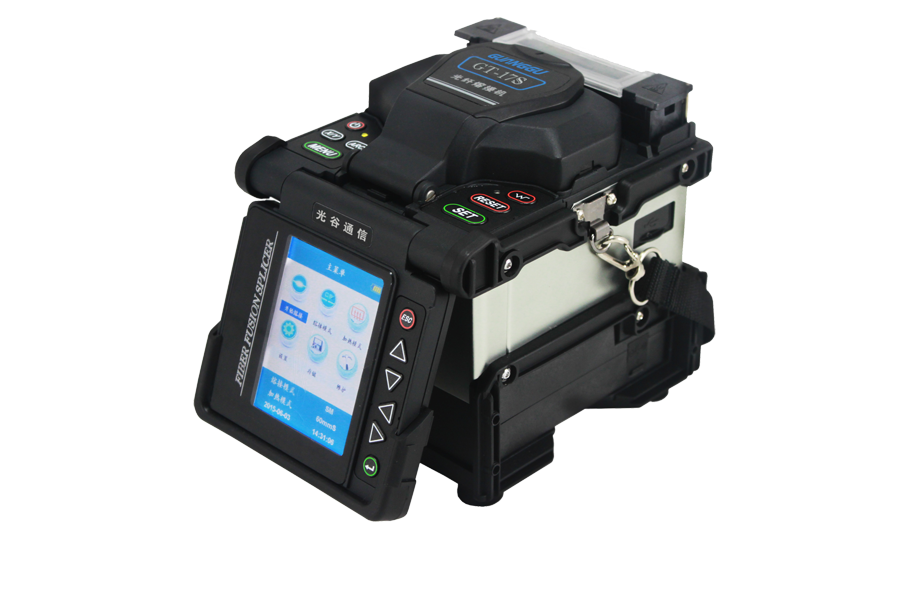

光纤是我们通信界常常用到东西,今天我光纤熔接机厂家在这篇文章中为大家分享常用光纤品种描述。
MMF(multi-mode Fiber多模光纤)
- OM1光纤(62.5⁄125um)
- OM2⁄OM3光纤(G.651光纤)其中:OM2—50⁄125um;OM3—新一代多模光纤。
SMF(single-mode Fiber单模光纤)
- G.652(色散非位移单模光纤)
- G.653(色散位移光纤)
- G.654(截止波长位移光纤)
- G.655(非零色散位移光纤)
- G.656(低斜率非零色散位移光纤)
- G.657(耐弯光纤)
从技术方面讲,你可以在FTTx上使用任何类型的光纤,但是,G.652和G.657却是我们最常使用的光纤。
◆G.651:长波长多模光纤(ITU-T G.651)50/125μm梯度多模光纤工业标准。ITU-T G.651即OM2⁄OM3光纤或多模光纤(50⁄125)。ITU-T推荐光纤中并没有OM1光纤或多模光(62.5⁄125),但它们在美国的使用仍非常普遍。主要应用于局域网,不适用于长距离传输,但在300至500米的范围内,G.651是成本较低的多模传输光纤。
◆G.652:常规单模光纤(色散非位移单模光纤),截止波长最短,既可用于1550NM,又可用于1310NM。其特点在设计和制造时的波长在1310nm附近时的色散为零,1550nm波长时损耗最小,但色散最大。(1310nm窗口的衰减在0.3~0.4dB/km,色散系数在0~3.5ps/nm.km。1550nm窗口的衰减在0.19~0.25dB/km,色散系数在15~18ps/nm.km。)主要缺点是在1550波段色散系数较大,不适于2.5Gb/s以上的长距离应用。
G.652A⁄B是基本的单模光纤,G.652C⁄D是低水峰单模光纤。
G.652.A、G.652.B、G.652.C和G.652.D光纤光缆的特性
|
光纤类型 |
G.652.A |
G.652.B |
G.652.C |
G.652.D |
|
|
模场直径 |
范围 |
8.6-9.5μm |
8.6-9.5μm |
8.6-9.5μm |
8.6-9.5μm |
|
包层直径 |
标称 |
125.0μm |
125.0μm |
125.0μm |
125.0μm |
|
色散 |
λ0min |
1300nm |
1300nm |
1300nm |
1300nm |
|
λ0max |
1324nm |
1324nm |
1324nm |
1324nm |
|
|
S0min |
0.093ps/nm2。km |
0.093ps/nm2。km |
0.093ps/nm2。km |
0.093ps/nm2。km |
|
|
衰减 |
1310nm |
0.5 dB/km |
0.4 dB/km |
—— |
—— |
|
1550nm |
0.4 dB/km |
0.35 dB/km |
0.3 dB/km |
0.3 dB/km |
|
|
1625nm |
—— |
0.4 dB/km |
—— |
—— |
|
|
PMD系数 |
M |
20 cables |
20 cables |
20 cables |
20 cables |
|
Q |
0.01% |
0.01% |
0.01% |
0.01% |
|
|
最大PMD0 |
0.5ps/km |
0.2ps/km |
0.5ps/km |
0.2ps/km |
|
◆G.653:色散位移单模光纤。在1550nm波长左右的色散降至最低,从而使光损失降至最低。
◆G..654:截止波长位移光纤。1550nm下衰耗系数最低(比G.652,G.653,G.655光纤约低15%),因此称为低衰耗光纤, 色散系数与G.652相同 , 实际使用最少的一种光纤。主要应用于海底或地面长距离传输,比如400千米无转发器的线路。
◆G.655:非零色散位移光纤(NZ-DSF: Non zero-Dispersion-Shifted Fiber)。G.653光纤在1550nm波长时色散为零,而G.655光纤则具有集中的或正或负的色散,这样就减少了DWDM系统中与相邻波长相互干扰的非线性现象的不良影响。
第一代非零色散位移光纤,如PureMetro 光纤具有每千米色散等于或低于5ps⁄nm的优点,从而使色散补偿更为简便。
第二代非零色散位移光纤,如PureGuide 色散达到每千米10ps⁄nm左右,使DWDM系统的容量提高了一倍。
◆G.656:低斜率非零色散位移光纤。非零色散位移光纤的一种,对于色散的速度有严格的要求,确保了DWDM系统中更大波长范围内的传输性能。
◆G.657:耐弯光纤,也叫弯曲不敏感单模光纤,弯曲半径最小可达5~10mm。
ITU-T光纤系列中的最新成员。根据FTTx技术的需求及组装应用而生的新产品。
G.657A光纤与G.652光纤兼容,G.657B光纤无需与传统单模光纤在连接上兼容。
Description of the varieties of telecommunication fibers
There are the most common description of the varieties of telecommunication fibers.
MMF (multi-mode fiber)
- OM1 (62.5 ⁄ 125um)
- OM2 ⁄ OM3 (G.651). For OM2 (50 ⁄ 125um) and OM3 (New generation multi-mode Fiber)
SMF (single-mode fiber)
- G.652 (dispersion non-shifted SMF)
- G.653 (dispersion shifted SMF)
- G.654 (cut-off shifted SMF)
- G.655 (NZ-DSF)
- G.656 (low dispersion slope NZDSF)
- G.657 (bending insensitive SMF)
Technically you can use any fibers for FTTx as far as the optical budget allows, but the most common application for FTTx shall be by G.652 and G.657.
G.651 (MMF)
G.651's major application is LAN. It's not suitable for long-haul transmission, but cheaper transmission devices for MMF may be attractive within 300 ~ 500m reach.
ITU-T G.651 is another name for OM2 ⁄ OM3 or MMF(50 ⁄ 125).
ITU-T recommendation does not have OM1 or MMF (62.5 ⁄ 125) which is still popular in US.
The core of MMF(50 ⁄ 125) has a refractive index profile gradually changing from the center of the core to the cladding, which enables multiple of transmission light (mode) travel with nearly the same velocity.
G.652 (dispersion non-shifted SMF)
It is the most common SMF in the world.
It is tuned to minimize the dispersion (which gives the deformation to the signal) around the wavelength at 1310nm.
You can use 1550nm wavelength window for the shorter distance or with the dispersion compensating fiber or module.
G.652A ⁄ B is the basic SMF and G.652C ⁄ D is the category for Low-water-peak SMF.
G.652A, G.652 B, G.652C and G.652 D’s characteristics
|
Optical fibre types |
G.652.A |
G.652.B |
G.652.C |
G.652.D |
|
|
MFD--Mode Field Diameter |
Range |
8.6-9.5μm |
8.6-9.5μm |
8.6-9.5μm |
8.6-9.5μm |
|
Cladding diameter |
Nominal |
125.0μm |
125.0μm |
125.0μm |
125.0μm |
|
Dispersion |
λ0min |
1300nm |
1300nm |
1300nm |
1300nm |
|
λ0max |
1324nm |
1324nm |
1324nm |
1324nm |
|
|
S0min |
0.093ps/nm2。km |
0.093ps/nm2。km |
0.093ps/nm2。km |
0.093ps/nm2。km |
|
|
Attenuation |
1310nm |
0.5 dB/km |
0.4 dB/km |
—— |
—— |
|
1550nm |
0.4 dB/km |
0.35 dB/km |
0.3 dB/km |
0.3 dB/km |
|
|
1625nm |
—— |
0.4 dB/km |
—— |
—— |
|
|
PMD coefficient |
M |
20 cables |
20 cables |
20 cables |
20 cables |
|
Q |
0.01% |
0.01% |
0.01% |
0.01% |
|
|
Max. PMD0 |
0.5ps/km |
0.2ps/km |
0.5ps/km |
0.2ps/km |
|
G.653 (dispersion shifted fiber)
It is designed to minimize the dispersion at around 1550nm where the optical loss is the smallest.
G.654 (cut-off shifted fiber)
Official name for G.654 is "cut-off shifted fiber", but it is better known as low attenuation fiber.
Thanks to this low attenuation the major application for G.654 is in the submarine and terrestrial long-haul application such as 400km reach without repeater.
G.655 (NZ-DSF)
NZDSF is short for NZDSF for wide band transport fiber.
G.653 has designed to have zero dispersion at 1550nm, but G.655 has positive or negative dispersion intently.
The reason for that is to reduce the undesirable effect of the non-linear phenomenon which interfere with the adjacent wavelength in DWDM system.
The first generation NZ-DSF such as PureMetro has smaller dispersion of around or less than 5ps/nm/km to make the dispersion compensation easier.
On the other hand the second generation NZ-DSF such as PureGuide has larger dispersion of around 10ps/nm/km to enhance the DWDM capacity to double.
G.656 (low-slope dispersion NZ-DSF)
It is a kind of NZ-DSF which has stricter requirements on the dispersion slope which enables to guarantee the DWDM performance in wider wavelength range.
G.657 (bending insensitive fiber)
This is the latest comer in the ITU-T fiber series. The demand in FTTx and the assembly applications made new family.
G.657A is intended to be compatible with G.652, and G.657B is the free-style exhibition which does not necessarily comply with the conventional single-mode fiber in terms of interconnection.